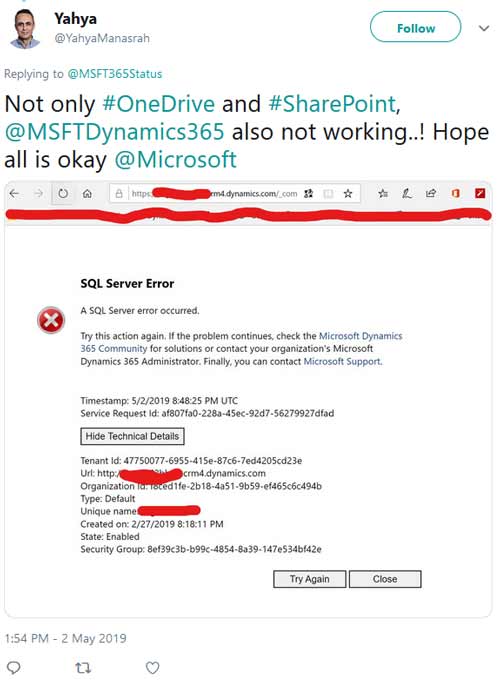Msft365status
Microsoft Corp. was hit by a massive cloud outage today that took most of its internet services offline.

Are Microsoft Services Down
Microsoft’s Azure cloud services, as well as Teams, Office 365, OneDrive, Skype, Xbox Live and Bing, were all inaccessible due to the outage. Even the Azure Status page was reportedly taken offline.
— Microsoft 365 Status (@MSFT365Status) March 16, 2020 While the issue was resolved, it still created a lot of problems for many employees as well as employers. After the pandemic of COVID-19 broke out, the governments of many countries asked companies, schools, and other institutions to grant the 'work from home' option to their employees.
- Microsoft 365 Status @MSFT365Status. We've successfully rerouted affected user traffic to an alternate processing infrastructure, which has restored service health and mitigated the impact. Please refer to MO232941 for additional detail. Microsoft 365 Status @MSFT365Status.
- — Microsoft 365 Status (@MSFT365Status) February 3, 2020. A little more than an hour later, Microsoft noted that an expired authentication certificate caused the outage. Microsoft said it is.
The first reports of the outage emerged from users on Twitter, and were confirmed by the website DownDetector, which showed that reports began flooding in at about 5 p.m. EDT. It says it received thousands of notices from Xbox Live, Teams and Office users.
Microsoft’s Azure Support account on Twitter posted the following message, redirecting users to an alternative Azure status page:
⚠️We are aware of an issue affecting the Azure Portal and Azure services, please visit our alternate Status Page here https://t.co/vGS3TQ8shs for more information and updates.
— Azure Support (@AzureSupport) April 1, 2021 R studio commands cheat sheet.
The cause of the outage was apparently a Domain Name System error. The Microsoft 365 Twitter status account stated that there is a “DNS issue affecting multiple Microsoft 365 and Azure services” shortly after the first reports of the outage appeared. The account then tweeted that the company was investigating a “potential DNS issue” at 5.56 p.m. EDT.
At 6 p.m. ET, the Microsoft 365 Status account posted another tweet, saying Microsoft is “evaluating our mitigation options.”
By 6.30 p.m. it looked as if Microsoft was regaining control of the situation. The Azure status page was back online and showed that the outage was a worldwide problem with “network infrastructure” down across every region. A status message said that a subset of users may experience “intermittent issues” with the company’s services.
At the time of writing, Microsoft appeared to be recovering from the outage. Microsoft 365’s Twitter status account posted another update at 6.35 p.m. EDT saying that traffic was being rerouted to resilient DNS capabilities and that it was already “seeing an improvement in service availability.”
Microsoft rerouted traffic to our resilient DNS capabilities and are seeing improvement in service availability. We are continuing to investigate the cause of the DNS issue. The next update will be provided in 60 minutes or as events warrant.
— Microsoft 365 Status (@MSFT365Status) April 1, 2021
It appears Microsoft has dealt with the issue rapidly, but the outage is nonetheless a big embarrassment for the company, coming just two weeks after a similar incident. On March 15, Microsoft Azure was also hit with an outage, resulting in Office 365, Teams and Xbox Live all being taken offline for about four hours.
Microsoft blamed that issue on “a recent change to an authentication system.”
Analyst Holger Mueller of Constellation Research Inc. told SiliconANGLE that an outage of this scale doesn’t just harm Microsoft, but the reputation of the entire cloud industry. He said DNS issues have traditionally been the most common cause of outages at Microsoft, and that the company would do well to rethink its network management approach and try to reduce some of the complexity.
“The outage is a sign of aging infrastructure,” Mueller said. “Network infrastructure gets more and more complex over time, but Microsoft is traditionally good at addressing the issues it faces in Azure, so it will be interesting to see the lessons learnt from this incident.”
Image: geralt/Pixabay
Since you’re here …
Show your support for our mission with our one-click subscription to our YouTube channel (below). The more subscribers we have, the more YouTube will suggest relevant enterprise and emerging technology content to you. Thanks!

Support our mission: >>>>>> SUBSCRIBE NOW >>>>>> to our YouTube channel.
want to make a movie? have you heard of powerpoint?. … We’d also like to tell you about our mission and how you can help us fulfill it. SiliconANGLE Media Inc.’s business model is based on the intrinsic value of the content, not advertising. Unlike many online publications, we don’t have a paywall or run banner advertising, because we want to keep our journalism open, without influence or the need to chase traffic.The journalism, reporting and commentary on SiliconANGLE — along with live, unscripted video from our Silicon Valley studio and globe-trotting video teams at theCUBE — take a lot of hard work, time and money. Keeping the quality high requires the support of sponsors who are aligned with our vision of ad-free journalism content.
If you like the reporting, video interviews and other ad-free content here, please take a moment to check out a sample of the video content supported by our sponsors, tweet your support, and keep coming back to SiliconANGLE.
Have you ever tried to log into Office 365, Microsoft Teams,Outlook, or SharePoint Online and you get an error that won’t let you in? You wonder, huh, am I the only one? Is the system down? Well, there’s a pretty easy way to get notified when many of the apps and services in Microsoft 365 are down. For a video version of this post—which provides a demo on how to do it all—click play below.

And the way to do this is to use Twitter. I know for many of you it leaves a super sour taste in your mouth. But it turns out, the most timely and—at least in my experience and my opinion—best source for updates onMicrosoft and Office 365 status is the Twitter handle @MSFT365Status.
A Microsoft employee somewhere out in the Twitter ether is posting updates about service outages for us. The reason I trust this source the most is due to their past performance. Reputations still mean something, even in the fire-scape of 2020. And this handle almost always posts before anything shows up in the Microsoft 365 Admin Message Center. It’s also easy to follow updates because updates are added to the thread, so you can see what time they were posted.
See? Twitter can be useful. It’s not just a hell hole of politics, the Kardashians, and conspiracy theories.
To get these notifications, open up your iOS or Android phone or tablet, open your app store, download Twitter, and create an account. Once you’re logged in, search for @MSFT365Status. Click Follow. Then click the little bell icon. This will send push notifications on your phone. If you haven’t allowed the Twitter app to send push notifications on your phone, you’ll have to allow them now. And that’s basically it. The next time they tweet, you’ll get a push notification.
Now, this isn’t perfect. Unfortunately these tweets are still written by technical people with the intention of a technical audience. But you can definitely get through it.
For example, let’s look at the tweet below. Even though they mention Exchange Online, you can do a quick search to see what that means: hint, it means email and Outlook. While you won’t be able to access the issue item they reference if you’re not an admin, you can still follow the thread they update over the course of the outage.
Now if we look at the tweet below, it’s pretty clear that SharePoint email alerts were not working for whatever reason. It was resolved pretty quickly. No major issue, and it was written in reasonably standard everyday speak.
Now, why is this even necessary? Well, did you happen to notice a couple weeks that Microsoft Teams was down? Yeah, it was a MAJOR system outage, as the technical folks would call it. And technically, it wasn’t even Microsoft Teams. It was an underlying tool that makes Teams work. But it meant you couldn’t get into Teams, Outlook, SharePoint, Planner, and a number of other Office 365 apps. Office.com itself was even giving me a problem, so I couldn’t even edit Word files on my desktop since it requires me to be signed in. It was, frankly, a bit of a fiasco.
And I say all this knowing that when you watch this, my reference is completely outdated. But actually it’s not. Because it will happen again. Because, well, humans. Humans are fallible, humans built a system, system is fallible, system will break once in a while.
Now, Office 365 administrators have access to the Admin Message Center, which gives updates, but that’s not publicly available, unfortunately. And it means that your best bet if you’re not an administrator—which is like 99% of us—is to use Twitter. Sure, there are other options, but I find this to be the best one.
Microsoft Service Health
So that’s how you can keep up with the service status of Microsoft and Office 365. It’s not perfect. They may leave out information. It may be a little delayed sometimes. But it’s better than nothing and many times better than what our IT admins send us, which, many times is actually nothing.
Microsoft Office Status
Thanks so much for reading. Don’t forget I have another post covering 9 resources you should follow to stay up to date with the never-endingOffice 365 life cycle. And if there’s anything you think I left out here, please leave a comment below so others can learn. Happy dealing with your anxiety now that you’ll be getting updates on Office 365 status.

